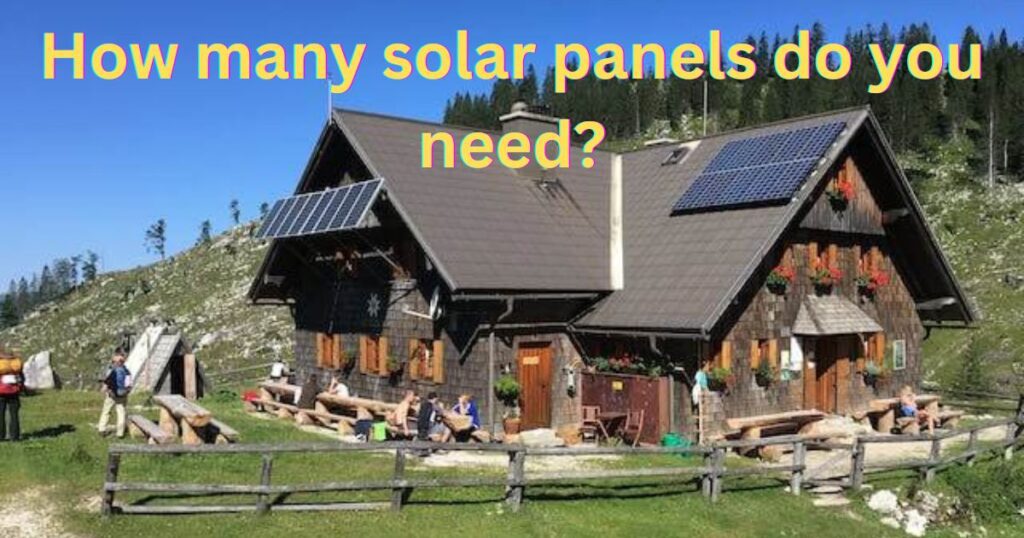Last updated on March 6th, 2025 at 04:02 am
How many solar panels do you need? It’s a question that many homeowners and business owners ask when considering the switch to solar energy. As the demand for renewable energy continues to rise, understanding the factors that determine the optimal number of solar panels for your home or business is essential.
From energy consumption and peak sunlight hours to panel efficiency and available space, finding the right balance ensures efficient energy production and cost-effectiveness. In this article, we’ll explore the key considerations and calculations involved in determining how many solar panels you need to power your home or business sustainably.
Solar Panel Calculator: How Many Solar Panel Do You Need?
(*) Required field
Importance of understanding the number of solar panels required
Understanding the number of solar panels required is crucial for anyone considering a transition to solar energy. This knowledge is essential for several reasons, all of which contribute to the effectiveness, efficiency, and financial viability of a solar energy system.
Below are detailed explanations of the importance of understanding the number of solar panels required:
Accurate Energy Production
The number of solar panels directly influences the amount of energy a system can produce. Understanding this number ensures that you generate sufficient electricity to meet your household or business needs.
Accurate calculations help avoid the risk of under-sizing the solar system, which could result in insufficient energy production. Conversely, over-sizing may lead to unnecessary upfront costs.
Financial planning
Determining the right number of solar panels is vital for accurate financial planning. It allows individuals or businesses to estimate the initial investment required for the solar installation.
Knowing the number of panels needed helps in calculating the return on investment (ROI) and determining the payback period. This financial insight is crucial for making informed decisions about the feasibility and affordability of a solar energy system.
Optimizing Available Space
Different solar panel types and sizes have varying space requirements. Understanding the number of panels required allows for optimal use of available space, whether on a rooftop, ground-mounted system, or any other installation location.
Space optimization is particularly important in urban environments where available space may be limited. Efficient use of space ensures maximum energy production from the available area.

Important parameters to calculate the number of solar panels you need
Your Energy Consumption
Understanding your energy consumption is paramount when sizing a solar panel system. By analyzing historical electricity bills, you can determine the average monthly and annual energy usage.
For instance, in the United States, the average annual electricity purchased by a residential customer is 10,791 kilowatt-hours (kWh), translating to around 899 kWh per month. However, consumption varies across regions, with Louisiana recording the highest annual electricity purchases per residential customer at 14,774 kWh and Hawaii the lowest at 6,178 kWh per residential customer.
Identifying peak usage periods is essential as they directly impact the required solar panel capacity. This information enables you to gauge when your energy demands are at their highest, allowing for the proper sizing of your solar system.
Accurate knowledge of your energy consumption is crucial, as it ensures that the solar panel system meets your specific needs without the risk of under-sizing or over-sizing.
Peak Sunlight Hours in Your Area
Understanding the impact of sunlight on solar panel energy production is crucial in determining the effectiveness of a solar energy system. Solar panels rely on sunlight to generate electricity, and the amount of sunlight a location receives directly influences their energy output.
Peak sunlight hours represent the period of the day when sunlight intensity is at its highest, typically around solar noon. On average, locations experience around 5 hours of peak sunlight, with Arizona having the highest at 7 hours and Alaska the lowest at 3 hours due to differences in latitude and climate.
Researching solar insolation levels for your specific geographic location provides valuable insight into the amount of sunlight available for solar energy generation. Solar insolation refers to the solar radiation received per unit area over a given period.
By understanding the solar insolation levels in your area, you can estimate the energy production of a solar panel system accurately. Additionally, considering seasonal variations in sunlight intensity is essential. Different regions experience changes in sunlight hours throughout the year due to factors like tilt of the Earth’s axis and weather patterns.
Wattage of the Solar Panels
Energy Loss in Solar Panels
How to calculate how many solar panels do you need
Formula to calculate number of solar panels you need:
Numbers of solar panels you need= (Your monthly energy need×1000)/(Wattage of the solar panels × Peak sun hours × 30)
Suppose, your monthly energy consumption is 1000 kWh. Considering 24% energy loss due to several factors, total monthly energy consumption is = 1,240 kWh.
In addition, lets suppose you need solar panels of 350 W and peak sunlight hours in your area is 6.
Number of solar panels you need= (1240×1000)/(350 × 6 × 30)= 19.6
You need 19.6 or 20 (rounded up) solar panels of 350 W to meet your demand of 1000 kWh per month.
The size of your solar panel system is:
Solar panel system size= (Number of panels you need × Wattage per panel)=20×350=7000 W or 7 kW.
Relation between solar panel system size and their energy production
Solar panel system size and the energy production by the system is related by production ratio. The production ratio of a solar panel system is a measure of the energy output relative to the installed capacity of the system. This ratio helps to estimate the average energy production of a solar panel system over time.
To calculate the production ratio, you can use the following formula:
Production Ratio = Total energy production (kWh) / Installed capacity (kW).
For example, if a solar panel system with an installed capacity of 10 kW produces 15,000 kWh of energy over a year, the production ratio would be:
Production Ratio = 15,000 / 10 = 1.5
This means that for every kilowatt of installed capacity, the system produces an average of 1,500 kilowatt-hours of energy per year. The production ratio provides valuable insights into the efficiency and performance of a solar panel system, helping users understand its energy output relative to its size.
Average number of solar panel installed in the United States
In the United States, the average energy consumption per month for households is approximately 899 kWh and average peak sunlight hours is 5 per day.
Then the average number of solar panels need in the United states= (Average monthly energy consumption × 1000)/(Average peak sunlight hours × wattage × 30).
Average monthly energy consumption with solar panel energy loss = 899×1.24=1114.6 kWh.
Then average number of solar panel installed =(1114.6×1000)/(5×400×30)=18.57 or 19 solar panels (rounded up).
The average U.S. household typically requires around 19 solar panels with a capacity of 400 watts each to meet their energy demand.
However, energy consumption can vary significantly from one state to another. For instance, in Louisiana, which has the highest monthly energy consumption at 1231 kWh and an average of 4.9 hours of peak sunlight, households may require approximately 26 solar panels of 400 watts each to meet their energy needs.
On the other hand, in Hawaii, which has the lowest monthly energy consumption of 515 kWh but enjoys 6 hours of peak sunlight, households may need approximately 9 solar panels of 400 watts each to satisfy their energy requirements.
Number of solar panels needed for specific system sizes
Numbers of panels needed for a specific system size depends on the production ratio. In the United states average energy consumption is 10,971 kWh and someone need to install 19 solar panels of 400 W to meet meet this energy demand.
The size of the solar panel system is 7.6 kW and the production ratio is 1.4. In the table below we have estimated the number of panels you need for a specific size solar panel system:
|
System size
|
Solar panels you need |
| 1 kW | 2 |
| 3 kW | 7 |
| 4 kW | 10 |
| 5 kW | 12 |
| 6 kW | 14 |
| 7 kW | 17 |
| 8 kW | 19 |
| 10 kW | 24 |
| 12 kW | 29 |
| 15 kW | 36 |
How does your home size affect the number of solar panels you need?
With the average size of a solar panel being approximately 17.606 square feet and the installation requiring 19 panels, the total minimum space required for the installation can be calculated as follows:
Minimum space required = Average size of a solar panel x Number of panels = 17.606 square feet/panel x 19 panels ≈ 334.714 square feet.
The minimum space required for installation depends on various factors, including the size and efficiency of the panels, as well as local regulations and building codes. Generally, solar panels require unobstructed access to sunlight for optimal performance. If a home has limited roof space available, adjustments can be made to the wattage of the panels to accommodate the space constraints.
One approach to adjusting wattage is to select higher-efficiency panels that can generate more electricity per square foot. These panels typically have a higher wattage output, allowing for greater energy production in a smaller space.
Additionally, innovative mounting solutions and panel configurations can help maximize the use of available space, such as tilt frames or tracking systems that optimize sunlight exposure throughout the day.
Number of solar panels you need calculated from electricity bill
| Electricity bill | Number of panels |
| $ 100 | 13 |
| $ 120 | 15 |
| $ 145 | 19 |
| $ 200 | 26 |
| $ 300 | 38 |
Wrapping up!
In conclusion, determining the number of solar panels needed for your specific energy requirements involves careful consideration of various factors such as energy consumption, peak sunlight hours, panel wattage, and energy losses.
By analyzing historical electricity bills and researching solar insolation levels for your location, you can accurately estimate your energy needs and optimize the size of your solar panel system.
Additionally, selecting solar panels with an appropriate wattage and accounting for energy losses due to factors like temperature, shading, and inverter inefficiencies ensure realistic expectations and efficient system performance.

